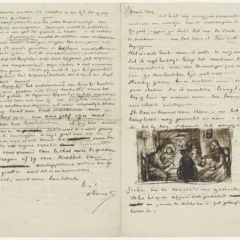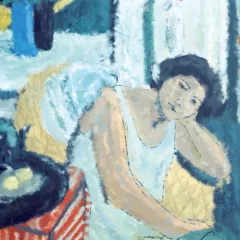Have you risked your life and your ankle crossing the Parkway to get from the Philadelphia Museum of Art to its annex? Do you wonder how the august institution, so slow to change, will embrace the digital era?
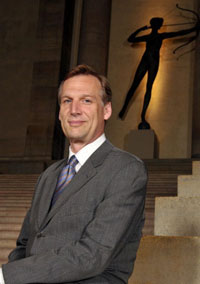
Those issues and more were addressed in a chat at the Philadelphia Art Alliance between PMA Director Timothy Rub and artist Diane Burko. The Tuesday night event, which kicks off a series of talks on the Art Alliance’s agenda (the next one features weather guy Adam Joseph–I kid you not), was attended mostly by an older crowd–but a crowd nonetheless considering it was a weekday night and competing with Mia Farrow in town getting honored.

About crossing the dangerous Parkway, Burko wanted to know if the trolleys were the final solution. She yearned for a bridge. Rub nixed that and a tunnel. But he did let on that the Parkway Council was working on a plan to change the street pattern and add new traffic lighting, to aid foot traffic–“in the future.” With the Barnes and Rodin buildings approaching readiness in a year, the issue is greater than access between the PMA and its Perelman Building. The trolleys are here to stay, he said, and added something about working with the Phlash tourist buses.
Embracing the digital world
Then Burko asked, Would the museum create a department to handle multimedia, film, video and other new forms of art.
The answer was a firm, No. Rub said he doesn’t like medium-specific curatorial departments, although he did admit that Photos and Prints weren’t going away.
And would it embrace these new forms in the collection? Yes.
Then Burko asked if the museum would participate in the Google Art Project, which allows the public to make an online visit to the museums’ exhibition spaces. She pointed out that even the Uffizi and MoMA were on board.
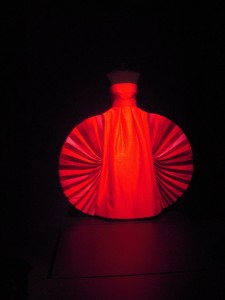
While Rub didn’t commit, he didn’t say no, either. And he disagreed with naysayers who don’t want to put the collection online. “There’s no distinction between how I can engage someone in the virtual and the real world. …Seeing a picture of the Eiffel Tower never made anyone not want to go to Paris.”
Of the museum’s 230,000 works, 80 percent are digitized–so far. Previously, the museum’s collection was accessible only via the galleries or printed catalogs–the tip of the iceberg. In other words, 225,000 works were inaccessible to nearly everyone on earth. “High quality images will be online,” Rub said.
Burko mentioned that the Brooklyn Museum was offering free tours to young tweeters in exchange for tweets. “Is someone in your organization trying to deal with a younger audience and social media?”
Yes, the marketing department. The Capucci exhibit Curator Dilys Blum tweeted on the development of the exhibition, and added video clips (you can now see videos here). She developed a following, Rub said. And going digital with the old comment books has been transformational. “Someone asked, How does Capucci pleat like that? Dilys Blum responded.” Here’s the Capucci discussion board/comment book on the museum’s website.
Public access
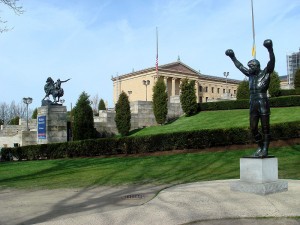
“How do you bring the Rocky guy up the steps?” Burko asked.
Rub agreed that access for many was a problem. “With pay-what-you-wish only one Sunday a month, now, revenues rose but attendance declined. We have to reduce barriers to entry.”
Rub had eliminated entry fees as director of the Cincinnati museum and inherited a no-fee structure when he moved on to the Cleveland museum, which, he said, had a very large endowment. “This museum [the PMA] is undercapitalized.” And then there’s the question of the museum’s hours. “The hours need to be later to respond to the habits of a changing society,” he said. He added that the museum’s record in making the young and people of color feel more welcome was mixed.
The collection
The questions and answers about collecting Philadelphia art were predicatable. But the conversation about the nature of the PMA’s collection was less so.
Philadelphia’s is “a collection of collections…[that] bear the stamp of their collectors. It’s full of highs and lows and full of extraordinary things.” He contrasted it to Cleveland’s collection, which is encyclopedic [because they could afford to build according to a curator’s plan, by acquisitions], but short on masterpieces.
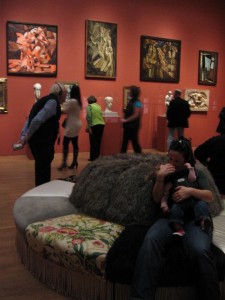
A case in point was last year’s exhibit Picasso and the Avant Garde in Paris. Of 215 works shown, 205 were from the collection. “As you walked through, the density was unrivaled elsewhere in the country, especially in the gallery with Virgil Marti’s Pouffe.
“My jaw dropped. There’s not another museum that can rival the depth and texture.”





